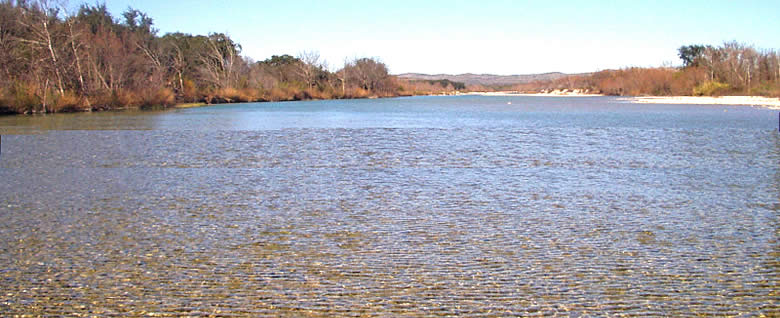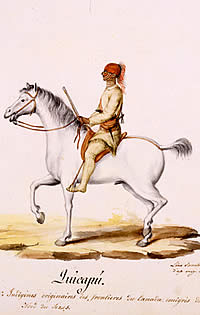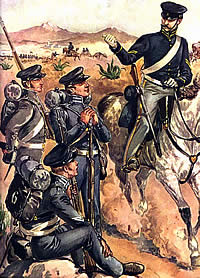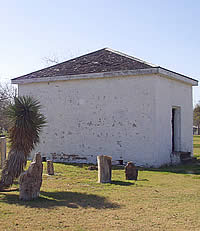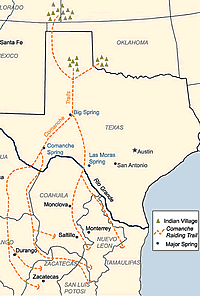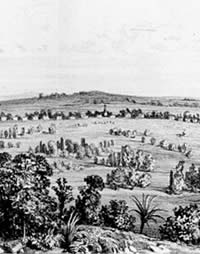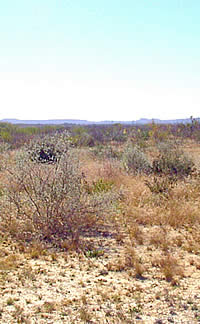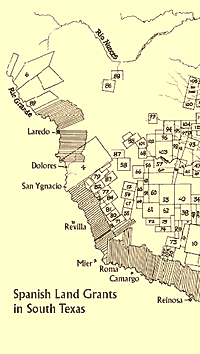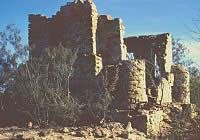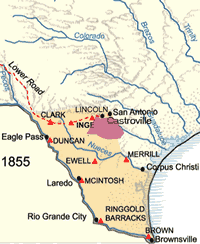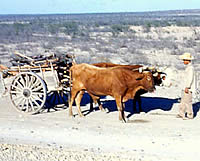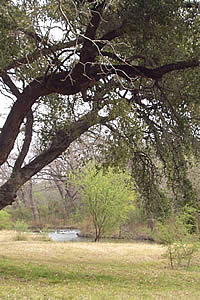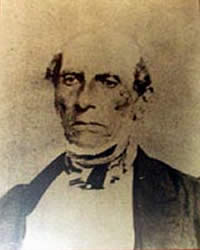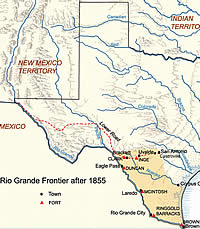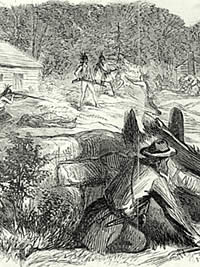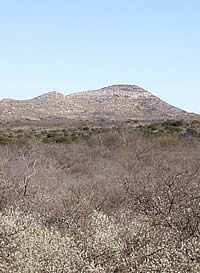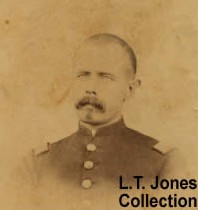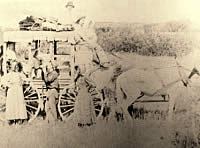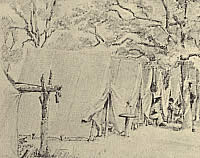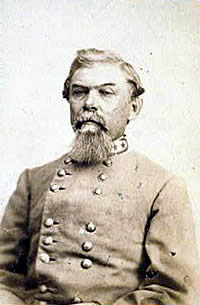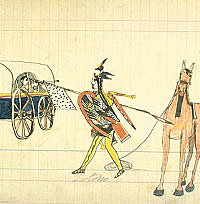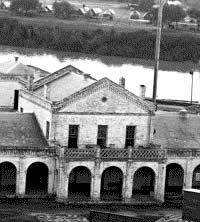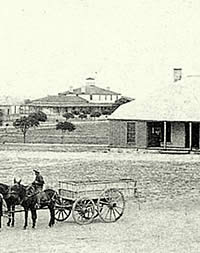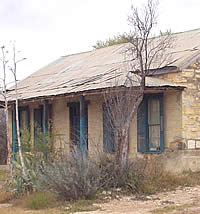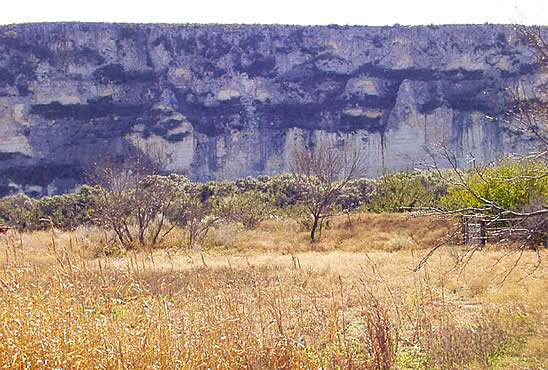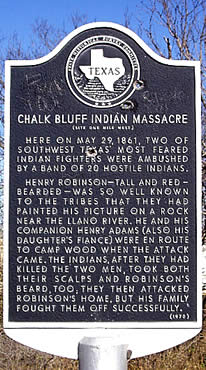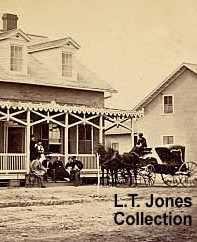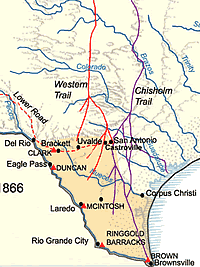
U.S. forts and settlements in the
Rio Grande frontier after the Civil War. Cattle trails
from south Texas to markets in the north mark the development
of the cattle industry.
|
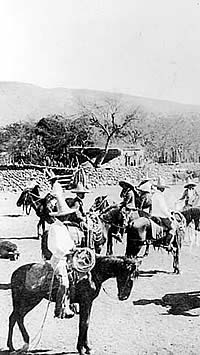
Mexican cowboys branding cattle in
south Texas. The rise of the cattle industry after the
Civil War spurred raids and rustling by Indians and
bandits. Courtesy Texas State Library and Archives Commission.
|
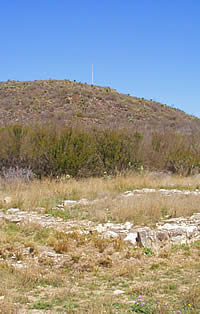
Ruins of structural foundation at
Fort Inge with Inge Hill in the distance. Photo by Susan Dial.
|
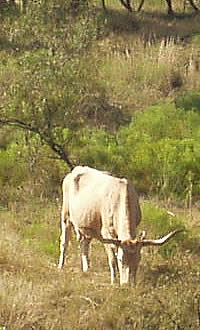
Texas longhorn. After the Civil War,
thousands of wild longhorn cattle were driven up trails
to high-paying markets in the north. Photo by Susan Dial.
|
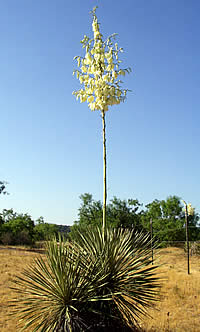
Yucca in bloom in south Texas. Photo by Susan Dial.
|
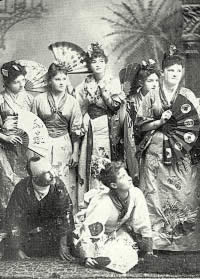
Fort Clark entertainment, 1887. Costumed
officer and wives shown performing the Gilbert and Sullivan
operetta, "The Mikado." Photo, Vinton Trust.
|
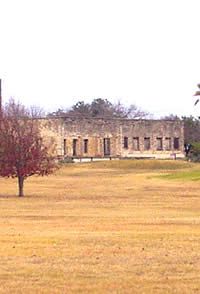
Fort Clark today. The post has become
a private resort, with the old parade ground now used
as a golf course. Photo by Susan Dial.
|
|
United States troops vacated all of the Texas
forts when the state seceded. "Rip" Ford's Texas
Mounted Rifles were primarily responsible for defense of the
border against Indians, Mexicans, and United States forces
early in the Civil War, and Ford returned to the Rio Grande
late in the conflict to participate in its last battle.
The border posts were the first to be reoccupied
by the U.S. Army after the war ended. The army had some 40,000
soldiers in the state by the fall of 1865, most located either
among the population centers to assist in Reconstruction duties
or on the Rio Grande to guard against the French who were
then occupying Mexico.
Within two years, the wartime volunteer units
had mustered out of service, and the remaining regulars numbered
only about 5,000. The units posted to the Rio Grande included
the 41st Infantry, a regiment of black enlisted men and white
officers. Colonel Ranald Mackenzie located the unit's headquarters
at Ringgold Barracks, and by the fall of 1868, the 41st provided
garrisons for Fort Clark, Fort Duncan, and Fort Inge. It shared
Duncan and Inge with companies of the 9th Cavalry, a regiment
also manned by black troopers and white officers.
When Company D of the 41st Infantry arrived
at Fort Inge, it was commanded by Lieutenant John L. Bullis.
Over the next 15 years, Bullis would become almost legendary
on the western frontier for his leadership of the army's Seminole-Negro
Indian scouts.
Fort Inge was abandoned in the spring of 1869.
The 41st Infantry's headquarters were transferred to Fort
McKavett, and the regiment was combined with the 38th Infantry
to form a new regiment, the 24th Infantry. From 1870 through
1872, three black units—the 9th Cavalry and the 24th
and 25th Infantry—provided the garrisons for Forts Clark
and Duncan.
By the mid-1870s, increased traffic and commerce
had combined with the rapid development of a cattle industry
to make the Nueces Strip a target-rich environment for Indians
and outlaws from both sides of the Rio Grande. The army's
pre-Civil War supply system had been instrumental in developing
wagon roads between Corpus Christi and Laredo (Fort McIntosh),
Laredo and Fort Duncan, and San Antonio and Fort Clark. New
communities had grown up near the forts—Brackett (or
Brackettville) near Fort Clark, Uvalde (an anglicized tribute
to the Spanish soldier Ugalde) near Fort Inge, and Eagle Pass
near Fort Duncan. They furnished materials and civilian labor
for army construction projects and served as supply centers
for the ranches that began to grow up in the region.
Spanish-Mexican cattle roamed wild by the hundreds
of thousands in south Texas after the Civil War. Locally,
they were worth as little as $2 per head, but on the northern
markets they brought $40 or more. Development of a system
to reach those markets set off an "open season"
of cow hunting in the brush country. Rustling and trafficking
in stolen livestock became profitable enterprises.
In 1875, a gang of about 30 outlaws terrorized
travelers and residents in and around Corpus Christi. A wounded
member of the band told his captors that the gang had come
from south of the Rio Grande in several smaller groups, and
had rendezvoused near the town with the intention of sacking
it completely. Texas Governor Richard Coke immediately directed
Leander McNelly, captain of a special company of rangers,
to deal with problems on the border.
As matters developed, international banditry
was beyond the effective control of state forces. The situation
ultimately improved only because of a series of U.S. Army
incursions into Mexico that could have provoked open warfare
between the two nations. The first of these expeditions, in
the summer of 1876 and fall of 1877, were directed by "Pecos
Bill" Shafter, commander at Fort Duncan. Shafter relied
primarily on 10th Cavalry troopers—the original "buffalo
soldiers"—and Bullis's Seminole-Negro Indian scouts,
supported by detachments of 24th and 25th Infantry. Several
attacks were made on Lipan or Kickapoo camps, most with some
degree of success.
Mexican authorities protested, but took no action
until Mackenzie led a larger expedition across the Rio Grande
in 1878. The effort was notable mainly for the confrontation
it produced with a Mexican army. Conflict was avoided, however,
and the affair prompted Mexico to keep a stronger military
presence near the border that helped suppress raiding in Texas.
Brackettville became the county seat of Kinney
County when it was organized in 1876. To the west, an agricultural
development sprung up around irrigation canals fed by San
Felipe Springs. The small town, San Felipe del Rio, received
a post office in 1883, shortened its name to Del Rio, and
became the county seat of Val Verde County in 1885.
Revolutionary activity in Mexico spilled over
the border into Texas after 1910, and the U.S. Army sent forces
across the Rio Grande in 1916. Although troops from Fort Clark
and Fort Duncan were not directly involved in the operation,
the political unrest provided sufficient reason for the army
to maintain its presence all along the international boundary.
Soon, the United States was preparing to enter World War I,
and both Fort Clark and Fort Duncan received a new lease on
life. Duncan became a training facility, and had 16,000 soldiers
on post in 1916.
At war's end, however, the futures of the two
forts were set on different paths. The army abandoned Fort
Duncan in 1927. The City of Eagle Pass began maintaining the
property, and in 1935 turned it into a park. With the onset
of World War II, the army accepted use of the property for
an officers club and swimming pool for personnel of the Eagle
Pass Army Airfield. The property has since reverted to historic
status. Seven of the original buildings remain, and the former
post headquarters houses a museum.
Fort Clark became home to the Fifth Cavalry
and was refurbished in the 1930s. The post entered its twilight
years as another world war approached. Its troopers participated
in cavalry war games near Marfa in 1936. Its last regular
garrison went to war in 1944, and the fort became a camp for
German prisoners of war. The army abandoned Fort Clark in
1946 and sold it for salvage. The property was operated as
a corporate retreat until 1971, when it became a residential
development. Most of the buildings have been converted to
private use. The Fort Clark Historical Society maintains a
museum in the former post guardhouse.
|
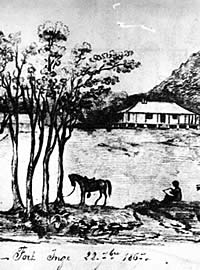
Detail of Fort Inge, drawn in 1867,
shortly before it was to be abandoned. The brush-covered
shelters, or "ramadas," on right, shelter
the tents of black soldiers posted there after the Civil
War. U.S. flag flies atop the basaltic hill known as
Pilot's Knob. Courtesy National Archives.
|
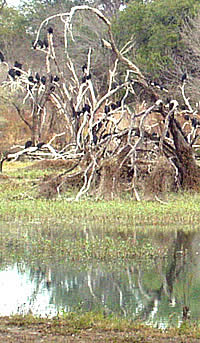
Buzzards roosting above Las Moras
creek at Fort Clark. Photo by Susan Dial.
|
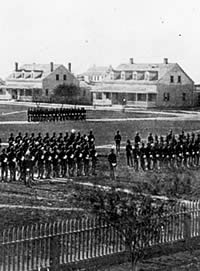
Drill at Fort Ringgold, Rio Grande
City, circa 1886. Like several of the border posts,
Fort Ringgold (formerly called Ringgold Barracks) was
to remain in operation until after World War II. Photo
from Crimmins Collection, Center for American History,
UT-Austin (CN# 02717).
|
Officers quarters at Fort Brown.
Photo courtesy of Lawrence Jones, III. View
large image. |
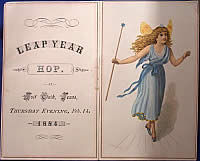
Dance card from an 1884 Leap Year
"Hop" at Fort Clark. Dances, plays, and musical
evenings provided social opportunities and entertainment
at the post, particularly in later years. Fort Clark
Museum.
|
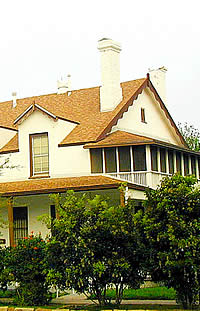
Once used as accommodations for soldiers,
this and other structures at Fort McIntosh now house
Laredo Community College. Photo by Mary Black.
|
|

